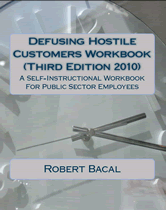
Downsizing -- The Long Term Effects
Originally written about downsizing within the public sector, the points in this article are no less applicable to any organization that is forced to undergo downsizing. Interestingly enough, almost all surveys and research examining the long term effects of downsizing indicate that companies that downsized ended up disappointed in the results. Layoffs may serve a short term need, but create huge longer term issues.
Few government departments or branches have escaped the necessity of downsizing. The last three or four years have brought almost constant cuts in staffing, and some departments have been "hit" several times. For many downsizing has become an annual process.
When managers are faced with downsizing, they tend to focus on the immediate and practical needs that emerge at the time when staff are being let go. After all, employees need to be selected and notified, one of the most difficult tasks for any manager. Jobs responsibilities need to be shuffled, and generally the period where downsizing is occurring is very busy and emotionally taxing.
Unfortunately, there is a tendency for managers to focus on those that are leaving rather than those that remain. This also holds true for central training and consulting agencies who are asked to support the laid off employees with career development help, counselling, and other supports. There is no question that laid off employees deserve and need these kinds of supports and services. Unfortunately, there is a tendency to forget that after the laid-off workers are gone, the "survivors" must soldier on, and the manager must deal with the long-term effects on the remaining organization.
We are now seeing the effects of downsizing on those that remain. One of the most telling comments is often put forth by employees a year or two after downsizing, and it goes like this: "Sometimes I think that the ones who were laid off are the lucky ones". They usually go on to describe a workplace where employees feel:
.
a lack of executive commitment to their functions
. confusion about the priorities
of their organization
. increased workloads
. confusion about their mandate
. a sense of being betrayed
by executives and managers
. a profound sense of distrust
. a sense of futility with
respect to long-term planning
. undervalued and unappreciated
In operational terms, this translates into a number of problems.
.
the organization moves towards less risk-taking and innovation
. destructive conflict tends
to increase
. internal competition for
resources increases
. individual staff members
devote less effort to working together and more attention to doing
things that will protect themselves.
. general listlessness and
lethargy
. decreases service levels
and increased public hostility
It is easy to understand these effects when they occur close to the time when down-sizing occurs, and remaining staff "grieve" the loss of friends and colleagues. But, these effects are now being seen as long as one or two years AFTER the downsizing period. There are indeed long term effects of downsizing that need to be addressed.
Understanding The Organizational Downcycle
To counter-act the long term effects of downsizing, managers need to understand how organizations slip into "downcycles".
An organizational downcycle can be characterized as a long-term process where the organization becomes progressively more depressed, insular, protective and confused. The important thing to note is that this process occurs slowly, sometimes imperceptibly, and that if the process is allowed to continue unchecked, it gets worse. The downcycling organization loses its positive momentum and enthusiasm. A vicious circle is formed. It snowballs. Bad feelings and depression become the norm rather than occasional, until, in extreme cases, the organization becomes unable to move effectively, and the work climate can become intolerable for everyone.
Because the process tends to be gradual, managers tend to assume that the problems that occur early in the downcycling will solve themselves without attention. It is easy to assume that staff will "get over" the effects of downsizing over time. This may be the fatal mistake, because if the process is left unmanaged, there is a good chance that staff will become more demoralized.
One
final point on the downcycle is in order. When an organization
is close to the bottom of a downcycle, it is extremely difficult
to turn the organization around. This is because levels
of trust, hope and enthusiasm are so low that
staff will have little faith in the effectiveness of any approach
that promises to be helpful.
Some Prescriptions
1. Proactive management activities are always required when downsizing occurs. Managers must realize that they "can pay now or pay later", and that delaying actions designed to revitalize the organization will result in a huge cost down the road.
Managers
should consider that the period immediately after downsizing is
critical. Action or inaction during this period will determine
whether the organization moves into a depressed downcycle, or
makes the commitment to move forward. Downsizing time should
also be a time when the organization's mandate and vision are
revisited. It should be a time when the manager
dedicates him/herself to the long-term health of the organization
by clarifying, supporting and building trust. Above all,
this is the time where the manager's prime responsibility is to
communicate, both with staff, and with executives. One focus
of communication should be clarifying mandate, vision, priorities
and commitment levels.
2. Proactive long-term approaches should also be applied by any central agencies charged with "helping" downsizing organizations. Support should be offered to those that are displaced, but, in the long term, help offered to "survivors" will be much more important in determining organizational health. As a manager, ask, or demand that these services be made available by central agencies, or procure them from private vendors, if the central agency won't do the job.
3.
If you are in the unfortunate position of managing an organization
that is "downcycling", you need to be aware of two things.
First, it will get worse if neglected. Second, interventions
to turn the cycle around must be considered as long-term projects.
One shot consulting or training isn't going
to do much, and it may be damaging. Remember that your organization
may have been moving downward for a year or two, and that it is
going to take a substantial period of time to reverse the process.
Positive change will require a consistent effort on your part,
and may require consulting help over a period as long as a year.
We are seeing more of the long-term effects of downsizing on organizational health. When downsizing is undermanaged, there is the danger that an organizational downcycle will be created, and left to continue unchecked over several years. The results can be destructive to the organization and the individuals that work there.
It is far easier to avoid or correct this cycle at the time when downsizing occurs, and far less costly. It is important that downsizing trigger organizational renewal strategies immediately.
If proactive action is missing, or is ineffective, corrective actions down the road will require a long term commitment. Once an organization reaches the bottom of a downcycle, it will take considerable time to reverse the process.





